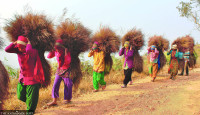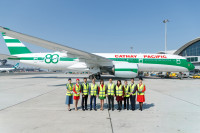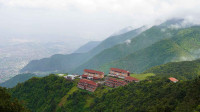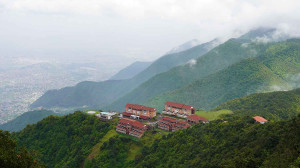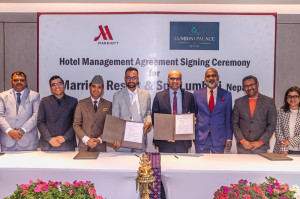Money
Wrong speed, unsafe cargo and lax safety caused Saurya crash
Incorrect takeoff speeds, flammable cargo, systemic flaws led to the CRJ-200 accident in Kathmandu last year.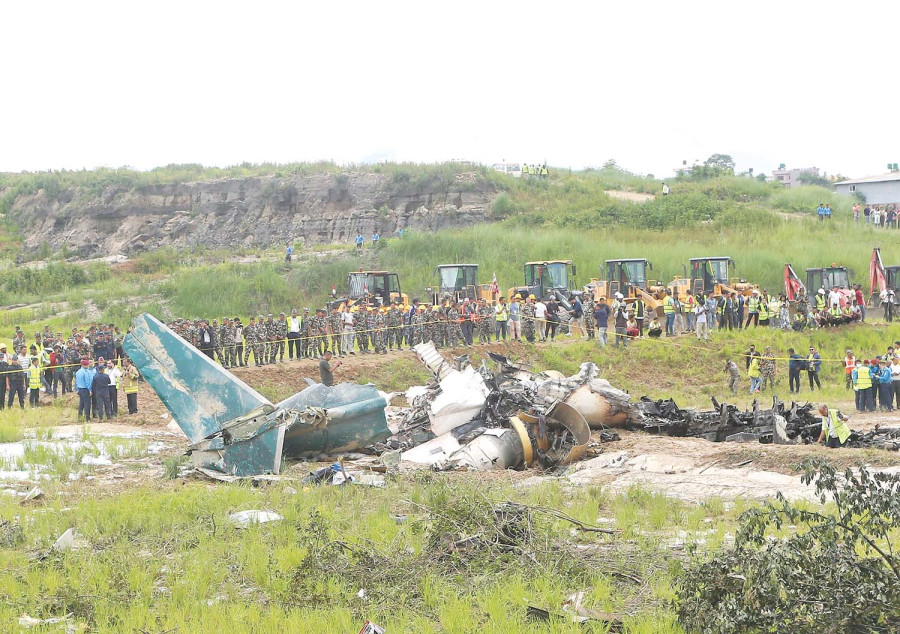
Sangam Prasain
The pilots of a Bombardier CRJ-200 aircraft operated by Saurya Airlines that crashed at Tribhuvan International Airport in Kathmandu in July last year, killing 18 of the 19 people onboard, used incorrect takeoff speeds—known as V-speeds—as they relied on a faulty speedcard, according to the final investigation report released Friday.
The relevant V-speeds for the flight were calculated based on the incorrect page for the 18,500 kg takeoff weight in the speed card, even though the actual takeoff weight was 18,137 kg, as per the load and trim sheet, a document that details the weight and balance of an aircraft for flights.
The report noted that V-speeds for 18,137 kg should have been derived from the speed card page for 18,500 kg. However, investigators found that the values listed for 18,500 kg in the speed card were identical to those for 17,500 kg, making them erroneous.
The flight crew conducted the takeoff using V-speeds for a 17,500 kg takeoff weight.
The relevant V-speeds used for the flight were V1 = 114 knots and VR = 118 knots.
These were calculated using an incorrect speedcard page corresponding to a take-off weight of 18,500 kg, while the actual weight stated in the load and trim sheet was 18,137 kg. For a take-off weight of 18,137 kg, the correct V-speeds should have been V1 = 117 knots and VR = 122 knots.
Additionally, based on the investigators’ revised estimated take-off weight of 18,300 kg, the appropriate V-speeds should have been V1 = 118 knots and VR = 123 knots.
The operator also failed to identify and address a recurring issue of high pitch rates during takeoff.
In aviation, the pitch rate refers to how quickly an aircraft’s nose moves up or down along its vertical axis. Maintaining a proper pitch rate is critical for safe operations, particularly during takeoff, landing, and other dynamic phases of flight.
During its analysis of previous takeoff performance involving the accident aircraft and other CRJ200s in the Saurya Airlines fleet, the Aircraft Accident Investigation Commission found a pattern of excessive pitch rates.
Specifically, investigators observed that flight crews consistently exceeded the standard pitch rate of 3 degrees per second during rotation.
One notable example was recorded on March 19, 2024, when the pilot-in-command of the accident flight had executed a takeoff with a peak pitch rate of 5.5 degrees per second.
In total, investigators identified 18 such instances on aircraft 9N-AME between 2023 and 2024, with pitch rates exceeding 4 degrees per second in all cases. The most extreme case occurred in January 2024, with a peak pitch rate of 5.8 degrees per second.
The March 2024 event involving the accident pilot-in-command represented the second-highest recorded pitch rate.
Excessive pitch rates during takeoff can result in a deep stall—a condition where the airflow over the wing is severely disrupted, leading to a loss of lift. This was consistent with the data observed during the accident flight. Although the CRJ aircraft manual explicitly warns flight crew about the dangers of high pitch rates and the associated stall risks, the accident crew appears to have exceeded safe limits regardless.
This pattern of behaviour raises serious concerns about pilot training, standardisation, and the effectiveness of oversight within the airline, the report said. On the accident flight, the pitch rate at rotation peaked at an abnormally high 8.6 degrees per second, far beyond recommended limits.
This excessive nose-up input likely played a direct role in the deep stall and subsequent crash.
The use of flawed data in the speedcards had gone unchecked for years. The investigation revealed that the speedcard had not been reviewed or approved by any authority.
The main culprit for the crash was identified as a “deep stall,” caused by the aircraft rotating too quickly at an incorrect takeoff speed. There were no reports of adverse weather or engine malfunction at the time.
On July 24, 2024, the CRJ-200 aircraft with registration number 9N-AME took off from Tribhuvan International Airport in Kathmandu for a ferry flight to Pokhara for heavy maintenance. The accident claimed the lives of 18 people on board.
Only the captain survived.
The aircraft had been grounded for 34 days before the accident. On July 22, 2024, the left and right main landing gear assemblies were restored.
A return-to-service check was completed on the morning of the event flight, and the aircraft was cleared as a ferry flight, meaning it should be flown without passengers for maintenance purposes.
However, the report highlighted severe lapses in preflight planning and management, pointing to gross negligence on the part of the airline. The flight crew did not cross-verify the calculated takeoff speeds. The first officer calculated them using incorrect data, and the captain failed to review them.
The takeoff speed was lower than required, making the aircraft struggle to gain altitude.
Within seconds of liftoff, the plane rolled sharply to the right. The right wingtip struck the ground, and the aircraft crashed within the airport boundary. The impact trail extended around 1,000 feet east of the runway.
Emergency response was delayed. A fire vehicle arrived one minute and 40 seconds after the impact, and it took 15 more seconds to spray carbon foam. Two other fire vehicles reached the site but did not assist immediately. Meanwhile, ground personnel rescued the captain before a fire broke out in the cockpit.
“Therefore, a timely firefighting effort was not apparent, nor was readiness displayed, to tackle the impending fate of the crew stuck in the cockpit,” the report stated.
It also pointed out the lack of a well-planned runway strip, hindering rescue crews’ access.
A runway strip—or safety area—helps ensure the safety of aircraft that veer off, overshoot, or undershoot the runway, and also facilitates emergency response. The report suggested that had Kathmandu airport maintained a proper runway strip in accordance with ICAO guidelines, the crash would have occurred within this zone, likely allowing for more effective rescue efforts.
“The survival of the pilot-in-command shows that the accident was survivable, at least for the crew stuck in the cockpit, had the rescue efforts been properly coordinated or well prepared,” the report concluded.
Investigators also noted that both the east and west sides of the runway have low-lying areas—including the Saurya crash site—that do not comply with ICAO Annex 14 standards for runway strips. These areas are also difficult to access during emergencies.
Interviews by investigators with the family and colleagues of the first officer or co-pilot painted a troubling picture.
He was reportedly under financial and psychological strain. After failing a simulator test during his type training in Germany, he had to undergo extra sessions, extending his stay and raising costs. The additional costs were added to his training bond. The first officer covered food and lodging independently and even took out a loan in Germany, without informing his parents. He had been repaying it from his salary.
He had also incurred expenses during initial training, which further strained his finances. Though he was described as enthusiastic and dedicated to aviation, he was dissatisfied with the airline due to low pay, layoffs, and poor benefits. Being from a middle-class family and their only child, he had received full support from his parents, but interviews indicated he hid his financial stress from them.
Adding to the concerns, the first officer had previously been laid off and rehired. Due to low flight frequency at the airline, his recent flying experience and pay were minimal—potentially affecting his confidence and performance.
The report also detailed serious violations in cargo handling.
The aircraft carried equipment, tools, maintenance materials, and personal belongings. Because normal check-in procedures were bypassed, the marketing department had no official record of the baggage weight.
Ground personnel told the investigators that the store in-charge crudely estimated the baggage weight and used it in the loading manifest. Tools, equipment, and flammable fluids like lubricants and cleaning agents were loaded without proper weighing, recording, or securing. Some items were placed loosely on seats and aisles instead of the cargo hold. No straps, nets, or tie-downs were used.
Untrained, non-ground staff handled the loading.
The aircraft was not authorised to carry hazardous goods, but the wreckage included items like hydraulic fluid, engine oil, and contact cleaners. Investigators even found hydraulic fluid spilt across the burnt cabin floor.
Flight preparations were equally lax.
The first officer began pre-flight checks early. The captain arrived at 10:40 am—30 minutes before takeoff—and provided limited supervision. They briefly considered cancelling the flight due to delays in boarding more people.
At 11 am, the crew was told to wait for additional personnel. A minute later, the captain said they would cancel engine startup if boarding didn’t begin immediately. At 11:01 am, air traffic control asked if the taxi should be delayed, to which the crew requested 30 more minutes. However, by 11:02 am, the final personnel had boarded, and the cabin door was closed.
Both engines were then started. The left engine failed to start at first due to a lack of fuel flow, but started successfully on the second attempt.
The aircraft took off at 11:10 am, reaching an altitude of 50 feet in five seconds. It barely reached 100 feet before rolling sharply to the right and crashing to the east of Runway 02 [Koteshwar side]. The aircraft sank approximately 130 feet in four seconds.
The crash resulted in massive structural damage. The post-impact fire intensified due to the presence of flammable cargo. Most victims died from blunt force trauma, while others suffered fatal burns, the report said.
Despite being aware of the cargo placed in the cabin, the pilot-in-command and flight dispatcher did not object.
Additionally, 98.6 kg of passenger baggage was later found at the airline’s corporate office—removed from the crash site without authorisation, bypassing airport security and highlighting serious lapses in post-crash procedures.
The investigation exposed layers of negligence.
No one verified if the cargo was safe or stored correctly. The aircraft’s weight distribution wasn’t monitored. Dangerous goods were loaded despite the lack of a permit. Equipment wasn’t weighed before loading. Maintenance gear was stored in the cabin.
Non-essential personnel were onboard, safety guidelines were ignored, and cargo information was unreliable.
The centre of gravity wasn’t the primary cause of the crash, but poor loading contributed to the sharp nose-up movement that led to the deep stall, the report said.
The report paints a damning picture of Saurya Airlines' operational culture. From ignoring manuals and protocols to neglecting safety checks and allowing risky practices, the airline displayed a consistent pattern of systemic failure. This was not a one-off oversight—it was the result of long-standing institutional neglect and poor oversight, according to the report.




 13.05°C Kathmandu
13.05°C Kathmandu
